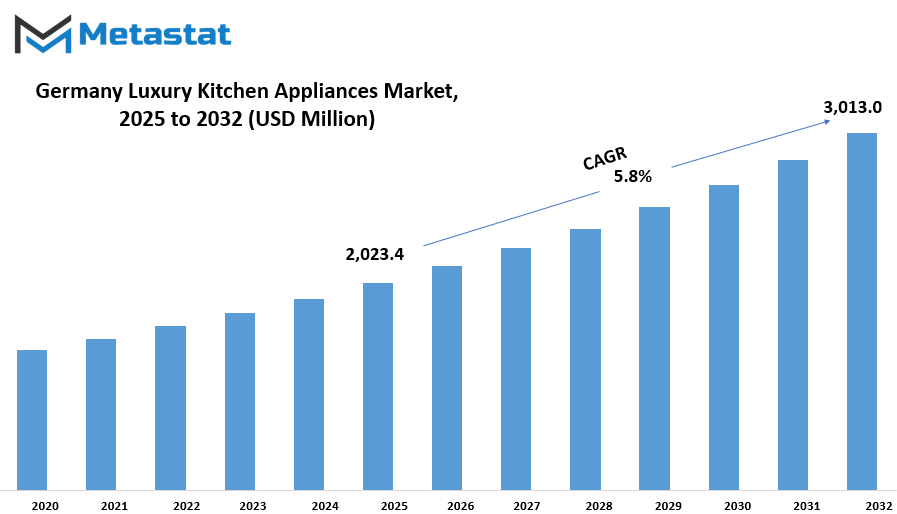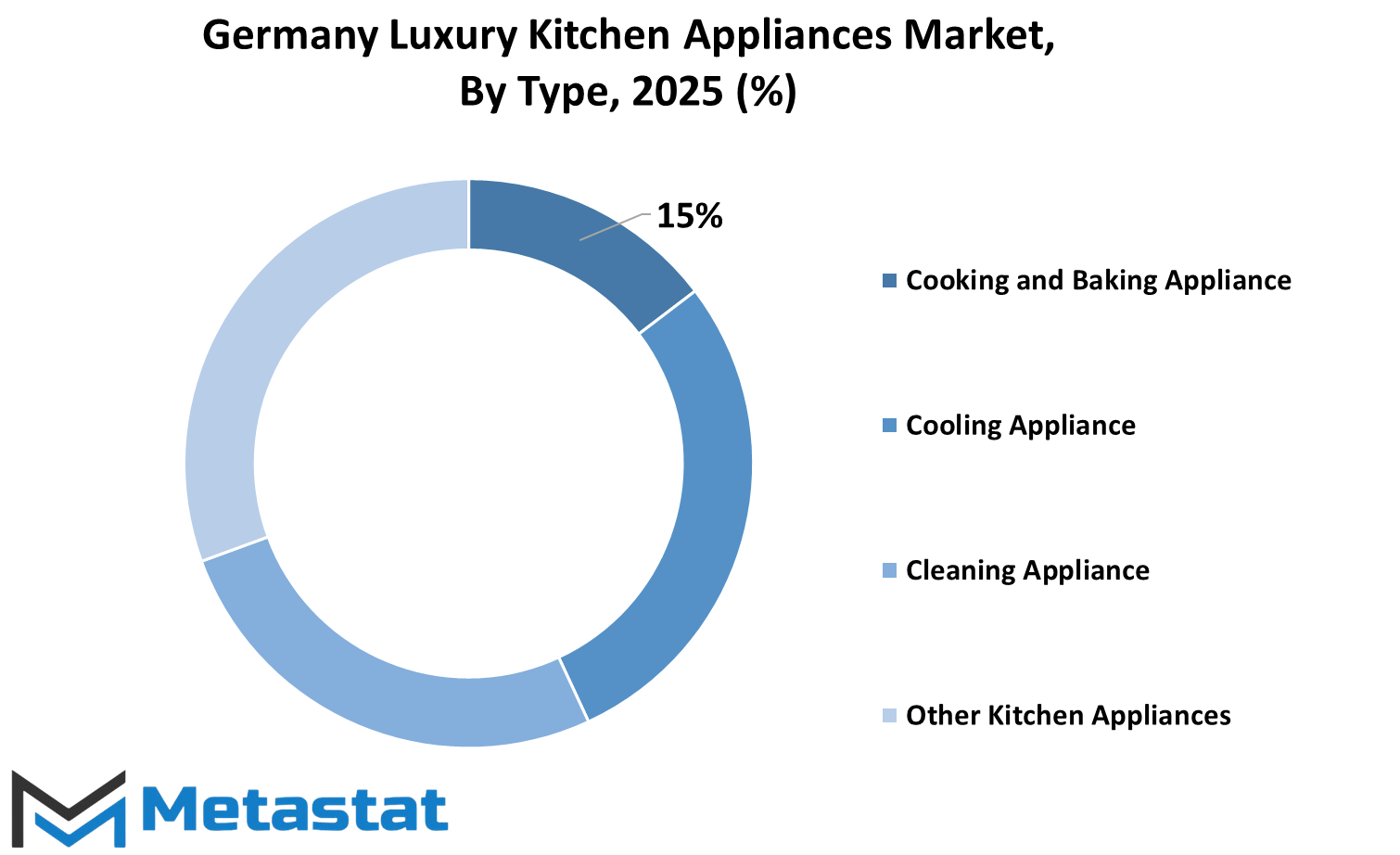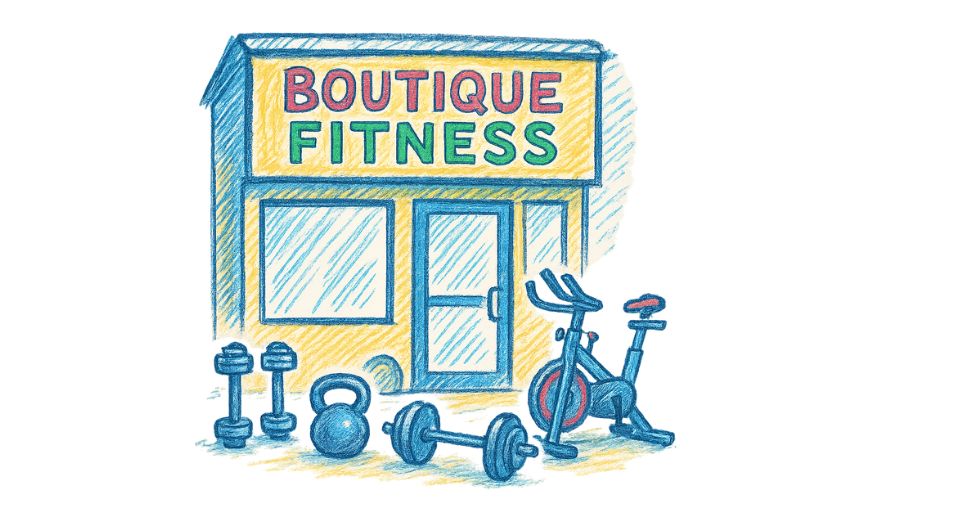MARKET OVERVIEW
The germany luxury kitchen appliances market will see a change in dynamics way beyond consumer choice or economic trends. Placed in the high-end home appliances niche, this segment will no longer be dictated by appearance or high-end functionality. The future will be about impenetrable undercurrents cultural change, design as a language of identity, and kitchens becoming expressive spaces that tell stories of personal taste and lifestyle aspiration.
In contrast to traditional appliances designed solely for convenience, luxury kitchen appliances will become edited objects of desire. They will transition from practical installations to emblematic statements. As families become more attuned to not only the way they live but also how that living is perceived by others, luxury appliances will function as visual extensions of self-image. The language of design will become personal, possibly even emotional blending heritage craftsmanship and silent technology, designed to not awe but fit in. This change in consumer culture will usher in a new era for the germany luxury kitchen appliances market, one where form and significance walk hand in hand.
The market will increasingly open up to other segments of society that were once outside this segment. This growth will not be driven by price affordability but by cultural redefinition. As food preparation and cooking come to hold more emotional significance within contemporary homes, appliances previously regarded as elite will become repositioned as heirlooms of memory and experience. Consumers will not only purchase what performs well but what speaks well to who they are. It won't be about price tags but the stories behind every product be that a brushed copper oven resonating mid-century Italian aesthetic or a hand-constructed refrigerator borrowing Swedish minimalism.
Technological shift will also introduce layers that challenge the perception of luxury. Appliances will be quieter, slimmer, less in-your-face yet more woven into the fabric of daily rhythm. Innovations will no longer shout for attention but rather blend into the background, providing convenience, not chaos. The germany luxury kitchen appliances market will eschew chasing complexity but aim towards an elegant simplicity that honors both design and functionality. Brands that previously paraded power or innovation as a sales feature will instead lean towards providing timelessness, emotional connection, and trust gained through longevity and craft.
What will be coming is not defined by flashy trends but by an unhurried, secure momentum towards purposeful living. Kitchens will be canvases where technology and personal narrative converge, and where cooking is as much nourishment as it is a mindful act. The Germany Luxury Kitchen Appliances industry will subtly drive this change less through intense reinvention and more through elegant evolution. As boundaries between performance, design, and emotion continue to blur, this market will continue to be a mirror of changing cultural stories. And that mirror will only grow deeper, subtly changing the way people engage with their homes and, more intimately, with themselves.
Germany luxury kitchen appliances market is estimated to reach $3,013.0 Million by 2032; growing at a CAGR of 5.8% from 2025 to 2032.

GROWTH FACTORS
The germany luxury kitchen appliances market is experiencing substantial growth due to multiple drivers. One major driver is the increasing disposable income in multiple regions throughout the world. Those who earn higher personal incomes will spend more money in home renovation and are willing to spend excess wage earnings on luxury kitchen appliances. These clients generally seek fashionable, efficient, and technologically advanced appliances that not simply ease the cooking process but also enhance and beautify their kitchens. In addition, the increasing source of smart homes plays a role in the increase of luxury kitchen appliance demand. People are placing more value on kitchens that offer ease of use through automation, connectivity, and intelligent controls, which are features that premium appliances provide.
But even with this encouraging expansion, there are certain obstacles that influence the rate and extent to which the products are taken up. The cost of luxury appliances is so high that it makes them beyond the reach of the middle classes. Although more affluent consumers will find these appliances necessities, they are beyond the means of the majority. This price differential sets a ceiling on just how far the market is able to spread among ordinary consumers. Another challenge is the stringent regulations on energy efficiency. Companies have to create products that are environmentally friendly without sacrificing performance and design, which can be costly and time-consuming. These regulations tend to delay product development and restrict the number of innovations that brands can make.
Nevertheless, there are robust opportunities that indicate further market expansion. Firms are putting money into the creation of smart and eco-friendly technologies, like power-saving aspects and remote-controllable devices. These innovations attract contemporary consumers who are concerned with convenience and environmental issues. They also provide an opportunity for brands to be different with new concepts and aesthetics. Moreover, online shopping has grown, allowing luxury kitchen brands to have wider reach. With e-commerce, consumers are able to browse and compare products across brands, read product reviews, and make a purchase online from the comfort of their homes. This increased exposure benefits brands by reaching more customers and gaining exposure in markets previously more difficult to penetrate through conventional retail channels.
Overall, the germany luxury kitchen appliances market is influenced by emerging lifestyles, technological innovation, and increasing home improvement interests. Although cost and compliance pressures are still challenges, innovation and digital media keep breaking barriers for development and competition.
MARKET SEGMENTATION
By Type
The germany luxury kitchen appliances market has seen rapid expansion, as more consumers are focused on installing more luxury appliances in their kitchens. Luxury appliances are not only utilized for cooking but they also add comfort, luxury and advanced technology to everyday life. The improvement of lifestyles and the pressure of quicker life styles has created a demand for appliances with luxury and functionality. Consumers are prepared to spend money on appliances that help them to do more in less time and add value into their homes. The kitchen, previously thought of as only a utilitarian space, is transforming into the central hub of new homes where families eat, entertain friends and enjoy family moments.
The Type segment in the luxury market is the most important to understand the impact of the changing tastes of consumers. The Type segment has been further divided into Cooking Appliances and Baking Appliances, Cooling Appliances, Cleaning Appliances and Other Kitchen Appliances. In this segment, Cooking Appliances and Baking Appliances dominate the category, worth over $296.3 million. The individual products that comprise this category are ovens, ranges and built-in stoves with smart controls, multiple cooking modes and style. Most of the consumers prefer to buy a luxury appliance that allows them to prepare meals faster and still provides them with proper control over their cooking. These appliances concentrate on retaining the quality of the food and the shelf life. As there is increased gourmet cooking as well as food storage demands, sophisticated cooling systems have gained popularity. Individuals these days seek refrigerators with individual temperature zones, touch screen displays, and power-saving features. Cleaning Appliances like dishwashers are also becoming popular, particularly those that include environmentally friendly modes, silent operation, and quick cycles. The aim is to lower effort without diminishing results.
Other Kitchen Appliances are smaller but vital tools assisting in everyday cooking, such as blenders, food processors, and mixers. While not as expensive as the primary appliances, these products still add to the luxury experience by providing intelligent features and high-end finishes. As more homes seek to establish hip and functional kitchen environments, the need in all of these segments continues to rise. With increased awareness, improved access to Germany brands, and more home improvement activities, the germany luxury kitchen appliances market is set to continue its growth. It not only indicates the change in the way individuals cook and clean but also the way they perceive the significance of their kitchen in their daily lives.

By Distribution Channel
The germany luxury kitchen appliances market continues to grow steadily because modern consumers desire products that not only blend performance and the high style into their homes but also fulfill their every day need of convenience enjoyment, and functionality. Today, consumers are more aware and knowledgeable than ever about technology in the home, and they also change their behaviours more quickly than in the past. The industry of luxury kitchen appliances is also changing with consumers earning more disposable income and as they value their lifestyles with a more concentrated focus on home renovation improvement, more luxury kitchen appliance consumers are being drawn to market to purchase not just performance strong appliances, but appliances that also have aesthetic appeal to the overall kitchen experience. As thae shoppers are spending more time cooking at home, their demands are loud for appliances such as smart ovens, automated refrigerators and energy-efficient dishwashers.
In terms of the channels of distribution for luxury kitchen appliances, these appliances have to be either directly sold to the consumer or through a distributor or intermediary, or what we refer to as point of purchase. The three major distribution channels of luxury kitchen appliances are as a recent study showed, E-commerce, Multi Brand Store, Exclusive Store, or Other. E-commerce is growing quickly for luxury kitchen appliances particularly as the last few years have shown the increasing popularity of online shopping. Consumers these days also appreciate how convenient it is to shop online because they can compare appliances on features and price, and have the appliances delivered to their homes. Most brands also improved their e-commerce value proposition by incorporating detailed product information, product videos, and customer reviews to help the buyer become informed about their purchase. This way, customers feel more confident about what they are purchasing. This personal interaction is still significant for many buyers, particularly when buying high-value products.
Single-brand stores, which retail only a single brand, provide a more customized shopping experience. Buyers visiting them tend to seek in-depth product information and close observation of the most recent features. Such stores typically mirror the image of the brand and foster an additional level of connection with customers. It is a preferred choice for some since it allows them to browse everything the brand has to offer at one location.
Finally, Other Distribution Channels can be specialty stores or home improvement centers. Though less frequent, they still contribute to serving particular customer segments or filling in areas for which other alternatives are not viable.
As the germany luxury kitchen appliances market continues to expand, the mode of selling these products will continue to evolve. But the requirement of balancing convenience, trust, and customer experience will always be significant for all channels.
By End Users
The germany luxury kitchen appliances market is classified by user type: residential and commercial. Distinguishing between the user types helps gain insights into the needs and expectations of the different user types. Residential users are individual home users, or simply households where households are seeking luxury appliances to improve the overall kitchen experience. Typically, these products blend advanced features with trendy designs to enhance basic cooking and food preparation. Home owners who are willing to spend on high-end kitchen appliances are likely looking for appliances that enhance a convenient, durable, stylish and desirable kitchen experience.
Commercial accounts are restaurants, hotels, catering operations, and food service companies. Commercial customers require appliances that can withstand continual use and can handle the often high activity level of food service. Their focus will be on performance, reliability, and efficiency to keep pace with the speed of their operations. They are designed to be more resilient and larger in size than household appliances so that they can cook food efficiently and effectively quickly and consistently while enduring constant use.
Residential as well as Commercial users are major players in the expansion of the luxury kitchen appliances market, but they have varying demands. Home consumers want products that combine aesthetics and functions to create a cooking experience in their home that was enjoyable and easy. When choosing appliances, the home consumer often chooses those that fit into the general appearance of their kitchen and follow their own taste and lifestyle. Commercial users are interested in finding appliances that will save time and increase productivity, to create a smooth workflow in the kitchen and keep customers happy.
Luxury kitchen appliances are still popular because of increasing incomes, changing lifestyles and a desire to cook and a focus on kitchen aesthetics. In homes, there are more and more people willing to purchase higher end appliances to create kitchens that are not only functional but also pleasing to the eye. In commercial situations businesses want equipment that will allow them to have better food and a quicker turnaround time.
Knowing these two end-user segments assists manufacturers and sellers in directing their efforts towards fulfilling special needs. They can create products designed for the needs of home users and provide heavy-duty and effective appliances for commercial use. This distinct delineation between Residential and Commercial users molds the luxury kitchen appliances market's development and expansion worldwide.
By Technology
The germany luxury kitchen appliances market can be defined based on the two common types of technology in the market; smart appliances and non-smart appliances. Smart kitchen appliances include advanced technology that allows the user to monitor and control the appliances via a smartphone, tablet, or voice assistant. These appliances help simplify life in the kitchen through convenience and efficiency, and more often than not saving time. For example, a smart oven can enable one to schedule cooking time remotely or adjust temperatures precisely, ensuring perfect results without having to keep track of the process minute by minute. These types of appliances typically have features like screens, wireless integration, and functionality that automates processes to make the cooking experience better.
Conventional kitchen appliances, on the other hand, follow a more traditional route by focusing on functional performance without other tech upgrades. These appliances are geared to offer repeatable performance with universal controls like knobs and buttons. Traditional appliances have numerous users who prefer them due to ease of use and longevity. They usually have a classic design esthetic that works for kitchens where functionality and simplicity are preferred over upscale elements. Conventional appliances may not have the benefit of a remote control, but they are likely to be more attractive to users that require machines that can be operable and serviced without software updates or connectivity.
Smart and traditional appliances both have their own niche in the high-end market because they serve different needs and wants. Some prefer the cutting-edge technology and smart automation from the smart appliances, while others prefer the familiar and sure experience from the traditional ones. The premium aspect means that these appliances will mostly use top-grade materials, advanced designs, and improved craftsmanship no matter what type of technology. Firms that are targeting this market focus on creating appliances that not only operate well but also lend a touch of sophistication to the kitchen space.
With advancements in technology, smart appliances will increasingly come into the limelight as they can be integrated with other smart home devices and increase efficiency. Nonetheless, standard appliances will still hold value for individuals who feel that they value simplicity and reliability. In summary, the world luxury kitchen appliances market is dictated by these two major technology categories, which each provide benefits that appeal to various types of buyers. This assortment enables buyers to find luxury appliances that fit their requirements and kitchen designs perfectly.
|
Forecast Period |
2025-2032 |
|
Market Size in 2025 |
$2,023.4 million |
|
Market Size by 2032 |
$3,013.0 Million |
|
Growth Rate from 2025 to 2032 |
5.8% |
|
Base Year |
2024 |
|
Regions Covered |
North America, Europe, Asia-Pacific, South America, Middle East & Africa |
.
REGIONAL ANALYSIS
The germany luxury kitchen appliances market is structured by geography into a number of key regions. These are North America, Europe, Asia-Pacific, South America, and the Middle East & Africa. These regions are then each broken down into smaller markets within countries to enable better comprehension and analysis of demand and trends across various countries of the world.
Beginning with North America, this comprises the United States, Canada, and Mexico. These nations are significant market players since their economies are strong and they have high demand for high-end kitchen products. Their consumers tend to go for appliances that combine sophisticated technology with stylish looks, hence driving growth in this sector.
Europe is another significant region, divided into the UK, Germany, France, Italy, and the Rest of Europe. They are famous for their history of design and innovation, which is evident in the brands of luxury kitchen appliances that customers favor. Demand here is driven by a mix of high standards of living and interest in current kitchen trends.
Asia-Pacific comprises India, China, Japan, South Korea, and the Rest of Asia-Pacific. It is quickly emerging as a major region for the luxury kitchen appliances market. As incomes rise in these countries and more individuals become better off, they are willing to pay for quality appliances. In addition, the growing number of new homes and shifting lifestyles help fuel this market's growth.
In South America, the market is segmented into Brazil, Argentina, and the Rest of South America. Although the market here is smaller than in other areas, it remains viable because of increased urbanization and growing consumers' interest in premium products.
Middle East & Africa is segmented into GCC nations, Egypt, South Africa, and the Rest of Middle East & Africa. The GCC nations, more specifically, are witnessing rapid growth due to their affluent population and emphasis on luxury life. Likewise, Egypt and South Africa are rising markets where demand for luxury kitchen appliances is gradually increasing.
Overall, the fragmentation of the germany luxury kitchen appliances market based on geography enables companies and analysts to better target specific needs and opportunities within a particular region. This will help in developing effective strategies and addressing the needs of consumers Germanyly.
COMPETITIVE PLAYERS
The germany luxury kitchen appliances market has experienced remarkable growth in the recent past, catalyzed by higher demand for quality, fashionable, and innovative products by consumers. Luxury kitchen appliances are no longer merely cooking implements; they are status symbols and lifestyle statements. The market comprises diverse high-end products ranging from refrigerators, ovens, cooktops, dishwashers, and other specialized kitchen devices to be used as a blend of superior technology and sophisticated design.
Major industry players are the ones who dictate trends and standards of performance and quality. Miele and Liebherr Appliances are among the companies most renowned for their commitment to craftsmanship and longevity. They continually bring appliances that not only come up to but also surpass customers' expectations by emphasizing accuracy and dependability. Thermador and SMEG S.P.A. provide products that focus on innovation and design, making sure kitchen appliances may be both functional and stunning. Viking Range LLC and Whirlpool Corporation, under its Bauknecht brand, introduce a blend of tradition and contemporary features in their products, which appeal to a broad customer base who desire luxury together with functional features.
La Cornue Germany and Gaggenau differentiate themselves by taking a different approach to fusing art with technology. They produce appliances that are often regarded as art forms, making kitchens rooms where aesthetics are equally valued as function. Electrolux Group remains an innovator with smart technology embedded in its appliances, offering convenience and energy savings. Sub-Zero Group, Inc. specializes in refrigeration solutions that maintain food freshness while adding a sleek look to the kitchen environment.
Collectively, these firms enrich the market through diversification and expansion by providing appliances that accommodate various tastes and needs. They spend a lot on research and development to make sure their appliances are in line with contemporary lifestyles and trends in cooking. Shoppers who seek luxury kitchen appliances can anticipate such attributes as accurate temperature control, silent operation, energy efficiency options, and sleek finishes that are compatible with their home furnishings.
Overall, the international luxury kitchen appliances market is influenced by these major players that continue to innovate and enhance their product lines. Their emphasis on the integration of functionality, technology, and design is what ensures that the kitchen continues to be a focal and attractive space in the household. With the increasing demand, the industry will continue to be shaped by these companies and provide new avenues for luxury living.
Germany Luxury Kitchen Appliances Market Key Segments:
By Type
- Cooking and Baking Appliance
- Cooling Appliance
- Cleaning Appliance
- Other Kitchen Appliances
By Distribution Channel
- E-Commerce
- Multi-Brand Stores
- Exclusive Stores
- Other Distribution Channel
By End Users
- Residential
- Commercial
By Technology
- Smart
- Traditional
Key Germany Luxury Kitchen Appliances Industry Players
- Liebherr Appliances
- Miele
- Thermador
- SMEG S.P.A.
- Viking Range LLC
- Whirlpool Corporation (Bauknecht)
- La Cornue Germany
- Gaggenau
- Electrolux Group
- Sub-Zero Group, Inc.
WHAT REPORT PROVIDES
- Full in-depth analysis of the parent Industry
- Important changes in market and its dynamics
- Segmentation details of the market
- Former, on-going, and projected market analysis in terms of volume and value
- Assessment of niche industry developments
- Market share analysis
- Key strategies of major players
- Emerging segments and regional growth potential








 US: +1 3023308252
US: +1 3023308252






